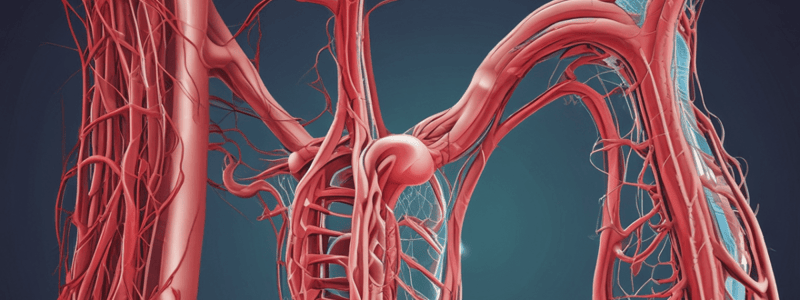Podcast
Questions and Answers
Pulse amplitude should be described on a scale of 0 to ______.
Pulse amplitude should be described on a scale of 0 to ______.
3
Chronic arterial insufficiency can cause ______ ulcer.
Chronic arterial insufficiency can cause ______ ulcer.
arterial
Venous disease is characterized by signs and symptoms of ______ waste buildup.
Venous disease is characterized by signs and symptoms of ______ waste buildup.
metabolic
One of the symptoms of arterial insufficiency is ______ pain.
One of the symptoms of arterial insufficiency is ______ pain.
Venous insufficiency can cause ______ discoloration and ulceration.
Venous insufficiency can cause ______ discoloration and ulceration.
To assess for pitting edema, press firmly with one finger for ______ seconds and release.
To assess for pitting edema, press firmly with one finger for ______ seconds and release.
Arterial disease can cause ______ pallor.
Arterial disease can cause ______ pallor.
One of the causes of arterial insufficiency is ______ blood pressure.
One of the causes of arterial insufficiency is ______ blood pressure.
The peripheral vascular system consists of a system of ______ veins and arteries.
The peripheral vascular system consists of a system of ______ veins and arteries.
Disorders which alter the normal flow of blood through the ______ and veins.
Disorders which alter the normal flow of blood through the ______ and veins.
A client with a diagnosis of PVD implies ______ disease rather than venous.
A client with a diagnosis of PVD implies ______ disease rather than venous.
Symptoms of peripheral vascular disease may include ______ in legs.
Symptoms of peripheral vascular disease may include ______ in legs.
During inspection and palpation of the arms, the nurse should check for ______ of the skin.
During inspection and palpation of the arms, the nurse should check for ______ of the skin.
The peripheral pulses include the ______ pulse, which is located in the leg.
The peripheral pulses include the ______ pulse, which is located in the leg.
If unable to palpate a peripheral pulse, the nurse should ______ to assist with the assessment.
If unable to palpate a peripheral pulse, the nurse should ______ to assist with the assessment.
The peripheral vascular system also involves the ______ system.
The peripheral vascular system also involves the ______ system.
Flashcards are hidden until you start studying
Study Notes
Peripheral Vascular System
- Consists of a system of intertwining veins and arteries that carry blood to and from the heart and lungs.
- Also involves capillaries and lymph system.
Disorders
- Affects the lower extremities more frequently than the upper extremities.
- Disorders alter the normal flow of blood through arteries and veins.
- Can involve both arterial and venous disease.
Subjective Data Collection
- Aching calves
- Claudication distance
- Change in skin color on arms/legs
- Numbness in legs
- Leg cramps
- Loss of sensation in legs
- Swelling/edema in arms or legs
- Pain in legs during exercise
- History of Diabetes, Thrombophlebitis, HTN, or Alcoholism
- Medications
- Lymph node enlargement
Objective Data Collection
- Inspect and palpate arms and legs:
- Symmetry in size
- Skin condition
- Clubbing
- Capillary refill
- Pulses
- Epitrochlear lymph nodes
- Inspect and palpate legs:
- Skin color, hair distribution, venous pattern, size (swelling or atrophy)
- Skin lesions or ulcers
- Symmetry
- Calf temperature
- Inguinal lymph nodes
- Pulses
- Edema
- Color Change Test
Pulse Assessment
- Temporal, Carotid, Radial, Ulnar, Brachial, Femoral, Popliteal, Posterior Tibial, and Dorsalis Pedis pulses
- Pulse amplitude: 0 (absent), 1+ (diminished), 2+ (normal), 3+ (full), or 4+ (strong, bounding)
Venous and Arterial Insufficiency
- Chronic arterial insufficiency
- Chronic venous insufficiency
- Arterial (ischemic) ulcer
- Venous (stasis) ulcer
- Diabetic changes
- Chronic venous disease
- Acute venous disease
- Superficial varicose veins
- Deep venous thrombophlebitis
Symptom Analysis
- Arterial insufficiency: signs and symptoms of O2 deficit
- Venous disease: signs and symptoms of metabolic waste buildup
- Pain analysis: location, character, onset, duration, aggravating factors, relieving factors, associated symptoms, and risk factors
Venous or Arterial Insufficiency
- Venous:
- Aching pain
- Pain worse at end of day
- Edema
- Coarse, thickened skin and nails
- Brown pigment discoloration
- Weepy, pruritic stasis dermatitis
- Arterial:
- Deep pain
- Claudication with walking
- Pain at rest
- Coolness
- Pallor
- Dependent rubor
- Thin, shiny skin
- Absence of hair
Causes of Arterial Insufficiency
- Abnormal cholesterol
- Diabetes
- Heart disease (CAD)
- High blood pressure
- Kidney disease
- Smoking
Arterial Insufficiency Symptoms
- Intermittent claudication
- Legs or feet may feel numb when at rest
- Legs also may feel cool to touch
- Skin may appear pale
- Pain and cramps at night
- Pain or tingling in the feet or toes
- Pain that is worse when leg is elevated
- Ulcers that do not heal
Studying That Suits You
Use AI to generate personalized quizzes and flashcards to suit your learning preferences.




